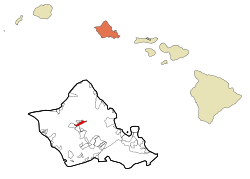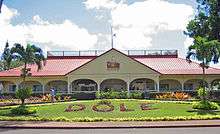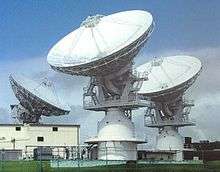Wahiawa, Hawaii
Wahiawa (Hawaiian: Wahiawā) is a census-designated place (CDP) in Honolulu County, Hawaii, United States, on the island of Oahu. It is located in the Wahiawa District, on the plateau or "central valley" between the two volcanic mountains that comprise the island. In Hawaiian, wahi a wā means "space of the wa people".[1] The population was 17,821 at the 2010 census.[2]
Wahiawa Wahiawā | |
|---|---|
 Location in Honolulu County and the state of Hawaii | |
| Coordinates: 21°30′9″N 158°1′23″W | |
| Country | United States |
| State | Hawaii |
| Area | |
| • Total | 2.4 sq mi (6.2 km2) |
| • Land | 2.1 sq mi (5.5 km2) |
| • Water | 0.3 sq mi (0.7 km2) |
| Elevation | 942 ft (287 m) |
| Population (2010) | |
| • Total | 17,821 |
| • Density | 7,400/sq mi (2,900/km2) |
| Time zone | UTC-10 (Hawaii-Aleutian) |
| ZIP code | 96786 |
| Area code(s) | 808 |
| FIPS code | 15-72650 |
| GNIS feature ID | 0364420 |
Lakes and reservoirs are rare in Hawaii, and Wahiawa is at once unique in being surrounded on three sides by Lake Wilson (also known as Wahiawa Reservoir or Kaukonahua). The town must be accessed by either of two bridges on Kamehameha Highway (State Rte. 80) across the narrow north and south arms of the reservoir. Outside of the reservoir, the town used to be surrounded by military bases and agricultural fields, but development is making its way up from the increasingly urbanized southern portion of the central plain. Still, there are significant U.S. Army facilities here, including Schofield Barracks, Wheeler Army Airfield, and East Range, an Army training area extending into the hills south and east of town. Schofield Barracks alone is larger than Wahiawa. Wahiawa is also the home of the U.S. Navy's Naval Computer and Telecommunications Area Master Station Pacific.
The U.S. postal codes for Wahiawa are 96786 and 96857.[3]
Geography
Wahiawa is located at 21°30′9″N 158°1′23″W (21.502574, -158.022938).[4]
Vehicular routes heading towards the North Shore from Wahiawa are Kamehameha Highway (State Rte. 80) to Haleiwa and Kaukonahua Road (State Rte. 801) to Waialua. Wheeler and Schofield are reached along Wilikina Drive (Wahiawa Bypass) (State Rte. 99), which bypasses Wahiawa from the south bridge, a road that eventually connects to both Kamehameha Highway and Kaukonahua Road northwest of town. Kamehameha Highway continues south (as State Rte. 99) past Wheeler to Mililani Town. However, the Interstate H-2 terminates at Wilikina Drive near the Kamehameha Highway intersection, and is a less congested route southward to Mililani and beyond to Pearl City and Honolulu via Interstate H-1. Kunia Road (State Rte. 750) runs from Wilikina Drive, between Schofield and Wheeler (on the bypass), then southward along the mostly still agricultural western side of the plain to Kunia and Waipahu beyond.
According to the United States Census Bureau, the CDP has a total area of 2.4 square miles (6.2 km2), of which 2.1 square miles (5.5 km2) is land and 0.27 square miles (0.7 km2), or 11.34%, is water.
Kaʻala, the highest peak on Oahu (4,003 feet or 1,220 metres), is located 5 miles (8 km) west of Wahiawa, overlooking Schofield Barracks.
Wahiawa Reservoir or Lake Wilson is located in Wahiawa, the second largest reservoir in Hawaii (302 acres (1.22 km2)). It is used to irrigate agricultural fields, including the Dole Pineapple Plantation fields located at the northern part of Wahiawa, all the way towards Oahu's North Shore where it empties.
Demographics
As of the census of 2000,[5] there were 16,151 people, 5,376 households, and 3,956 families residing in the CDP. The population density was 7,642.8 people per square mile (2,955.4/km2). There were 5,900 housing units at an average density of 2,791.9 per square mile (1,079.6/km2). The racial makeup of the CDP was 11.31% White, 2.02% Black or African American, 0.32% Native American, 45.77% Asian, 9.62% Pacific Islander, 1.83% from other races, and 29.14% from two or more races. 11.00% of the population were Hispanic or Latino of any race.
There were 5,376 households, out of which 31.3% had children under the age of 18 living with them, 49.2% were married couples living together, 18.0% had a female householder with no husband present, and 26.4% were non-families. 21.9% of all households were made up of individuals, and 10.5% had someone living alone who was 65 years of age or older. The average household size was 2.97 and the average family size was 3.45.
In the CDP the population was spread out, with 26.1% under the age of 18, 8.6% from 18 to 24, 26.6% from 25 to 44, 19.9% from 45 to 64, and 18.8% who were 65 years of age or older. The median age was 38 years. For every 100 females there were 94.6 males. For every 100 females age 18 and over, there were 91.4 males.
The median income for a household in the CDP was $41,257, and the median income for a family was $46,524. Males had a median income of $32,018 versus $25,287 for females. The per capita income for the CDP was $16,366. 16.7% of the population and 13.5% of families were below the poverty line. Out of the total population, 23.8% of those under the age of 18 and 9.9% of those 65 and older were living below the poverty line.
Government and infrastructure
The Honolulu Police Department operates the Wahiawa Substation in Wahiawā.[6]
A satellite gateway for the Iridium satellite phone network is operated by the DISA in Wahiawa.[7]
In the Hawaii State Legislature, Wahiawā is part of Hawaii State House of Representatives district 39 (currently represented by Lei Learmont)[8] and Hawaii State Senate district 22 (currently represented by Donovan Dela Cruz.)[9] In the Honolulu City Council, Wahiawā is part of district 2 (currently represented by Ernest Y. Martin.)[10][11]
Schools
Public schools
The Hawaiʻi State Department of Education operates the public schools.
Elementary schools in the CDP include ʻIliahi, Kaʻala, Samuel K. Solomon, and Wahiawā. Major Sheldon Wheeler is inside the CDP, while Wahiawā Middle School is adjacent to the CDP. Leilehua High School is inside the CDP.[12]
Private schools
Elementary schools
- Trinity Lutheran Church and School (Lutheran)
- First Baptist Church
- Hoʻala School
- Abundant Life United Pent Church
- Maranatha Christian Academy
- Hawaii Matsuritaiko
Bridges
- Karsten Thot Bridge (truss bridge, 1932)[13]
- Kaukonahua Bridge (1944)
- Wilson Bridge
Notable people
- Al Harris, professional football player
- Martin Iosefo, professional rugby player with the U.S. national rugby team
- Lia Marie Johnson, actress, singer and YouTube personality
- Adrian Murrell, professional football player
- Netane Muti, professional football player
- Kealoha Pilares, professional football player
- Lauvale Sape, professional football player
- Antonio Taguba, military general
- Charles Tuaau, professional football player
- Tadashi Wakabayashi, professional baseball player
- Corinne Watanabe, judge
Waianae Range
Gallery
 Dole Food Company was founded in 1851 in Wahiawa.
Dole Food Company was founded in 1851 in Wahiawa.- Dole's Plantation Garden Maze recaptured the world record of world's largest maze in 2008, occupying 137,194 square feet. The maze topped the record in 2001 of the Peace Maze in Northern Ireland, which currently measures in at 118,403.[14]
 Pineapple plantation field in Wahiawa is where the Dole pineapple industry started.
Pineapple plantation field in Wahiawa is where the Dole pineapple industry started. Wahiawa is the home of 25th I.D. Tropic Lightning since 1941. Currently basing more than 15,000 soldiers in Schofield Barracks and growing.
Wahiawa is the home of 25th I.D. Tropic Lightning since 1941. Currently basing more than 15,000 soldiers in Schofield Barracks and growing.
- Wahiawa Botanical Garden, one of the tourist spots in Wahiawa
- Wahiawa Botanical Garden
References
- Pili, Kamaka (March 8, 2018). "Aloha Authentic Features Moku O Wahiawa". KHON News. Retrieved 27 May 2018.
- "Profile of General Population and Housing Characteristics: 2010 Demographic Profile Data (DP-1): Wahiawa CDP, Hawaii". U.S. Census Bureau, American Factfinder. Archived from the original on February 12, 2020. Retrieved May 29, 2012.
- https://tools.usps.com/go/ZipLookupResultsAction!input.action?resultMode=0&companyName=&address1=&address2=&city=Wahiawa&state=HI&postalCode=&zip= USPS Zip Code Look Up
- "US Gazetteer files: 2010, 2000, and 1990". United States Census Bureau. 2011-02-12. Retrieved 2011-04-23.
- "American FactFinder". United States Census Bureau. Archived from the original on 2020-02-12. Retrieved 2008-01-31.
- "Contacting HPD Archived 2010-05-31 at the Wayback Machine." Honolulu Police Department. Retrieved on May 19, 2010.
- "Systems Architecture Description" (PDF). Archived from the original (PDF) on 2017-01-31. Retrieved 2011-10-14.
- Hawaii State Legislature. "House Members, 2011 Legislative Session". Retrieved 2011-02-26.
- Hawaii State Legislature. "Senate Members, 2011 Legislative Session". Retrieved 2011-02-26.
- City and County of Honolulu (February 20, 2011). "Honolulu City Council". Retrieved 2011-02-26.
- State of Hawaii Office of Elections (January 2010). "Election Map Oahu #5: Wahiawa and Mililani" (PDF). Retrieved 2011-02-26.
- "Wahiawa CDP." U.S. Census Bureau. Retrieved on May 21, 2009.
- Watanabe, June (March 27, 2007). "Historic bridge made vital link to North Shore". Honolulu Star–Bulletin. Retrieved September 14, 2012.
- "Dole Plantation maze recaptures world record title". The Honolulu Advertiser. September 9, 2008. Retrieved June 8, 2012.
